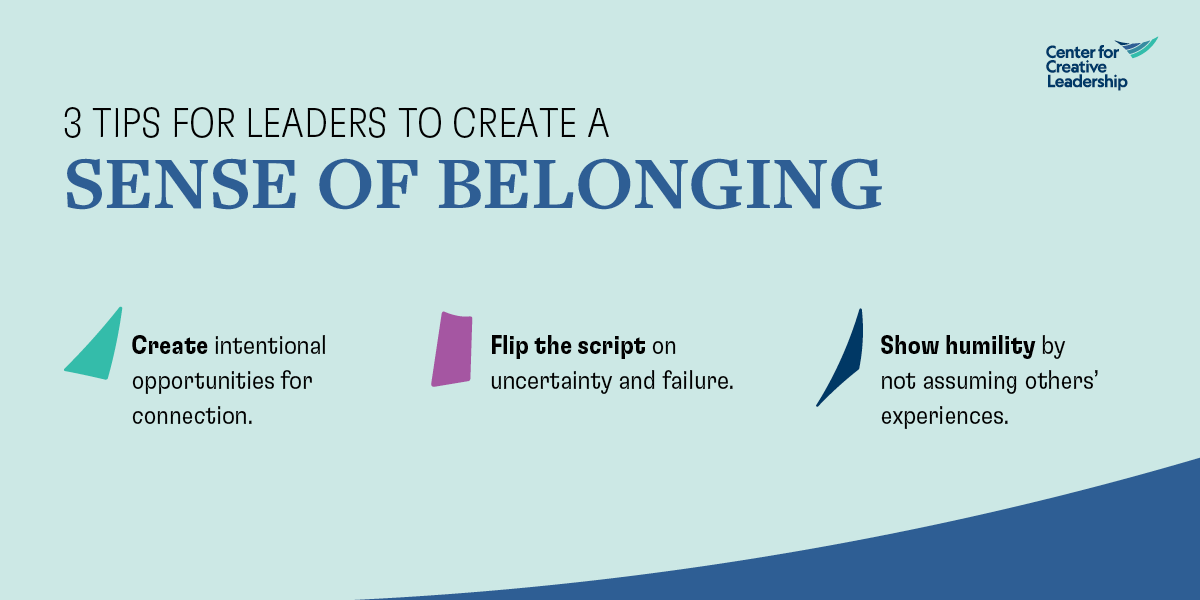Why Is Belonging in the Workplace Important?
Belonging — the belief that we are connected, supported, and respected — is a basic human need. It’s also a critical component of creating cultures of equity, diversity, and inclusion at work. Belonging in the workplace can pave the way for greater performance, innovation, satisfaction, and persistence through challenges.
Most leaders have a rough idea of what belonging is, but the true importance and value of belonging at work is probably more complex than they might imagine. Beyond just “Do I fit in here?” having a sense of belonging in the workplace involves answering multiple questions, such as:
- Can I connect with my peers professionally? Socially?
- Do I trust my peers, supervisors, and leaders?
- Do I feel like my unique perspective and experiences are valued?
- Am I able to share my authentic self?
- Am I free from worries about fitting in?
The Value of Belonging at Work
Research suggests that in the workplace, belonging and uncertainty about belonging both matter a lot, as they influence everything from job satisfaction and self-esteem to performance and wellbeing.
This is because when everyone consistently feels included and certain that they belong at work, people are more willing to take risks and more comfortable asking for (and giving) help. So part of the value of belonging in the workplace is that it actually helps to encourage more innovation in the organization and fosters innovative mindsets through open communication.
In addition, belonging is linked to increased persistence through challenges, bouncing back after failure, less likelihood to be thrown off by organizational shifts, and reduced employee turnover. For example, in a recent partnership with a leading global automotive organization, our researchers found that employee perceptions of inclusion, belonging uncertainty, and belonging at work were the strongest predictors of turnover intentions, burnout, and work-life balance.
In another study, building connection and belonging with other participants was also highlighted as one of the most valuable outcomes of engaging in leadership development training.
Luckily, research confirms that belonging uncertainty and belonging in the workplace can both be influenced by organizations and their leaders.
“By intentionally working to decrease uncertainties around belonging, you invite employees to set aside worries, concerns, or stress they’re carrying around with them,” shares Dr. Stephanie Wormington, CCL’s director of Global Strategic Research. “Then they no longer have to expend as much energy wondering if they belong at work, and they’re free to contribute to business objectives in a meaningful, productive, and fulfilling way.”
The Impact of Uncertainty About Belonging in the Workplace
Belonging & Belonging Uncertainty: 2 Sides of the Same Coin
We often talk about belonging as a single concept of feeling that you fit in. However, feeling as if you belong is only one side of the coin.
Before we can fully understand the value of belonging — and particularly the importance of belonging in the workplace — we must first understand the other side of the coin: a term known as “belonging uncertainty.”
People experience belonging uncertainty when they aren’t consistently sure whether they fit in at work. This vacillating sense of security can arise from feeling unlike others around you, either in appearance or cultural experiences. Belonging uncertainty is especially common if employees have a social identity that includes historically underestimated groups.
Often, employees experiencing belonging uncertainty worry about being treated negatively based on a stereotype. Without intentional supports, these employees may experience isolation, tokenism, and pressure to assimilate. “It’s like carrying a heavy backpack that you can never set down,” says Wormington. “If you’re walking around feeling weighed down all the time, it’s hard to engage fully, think creatively, or bring your full self to your work.”
Belonging uncertainty often leads people to hide aspects of themselves, or not put their whole selves out there. “That makes it tricky to detect when someone is feeling belonging uncertainty,” Wormington notes. When key indicators are missing, like someone seems hesitant to participate, you have a clue that the environment might not feel very welcoming to them.
Belonging uncertainty has an important tie to equity, too. According to Wormington, “If one person on the team is carrying around an empty backpack while another is geared up for a week-long backpacking trip, it’s going to be much easier for the first employee to walk up the hill. As leaders, we have to recognize and acknowledge the potential impact on how equitable and inclusive the workplace feels to employees carrying different weights.”
The concerns that arise from belonging uncertainty can cause people to interpret neutral events negatively.
Imagine that 2 employees give a presentation at a quarterly meeting, and neither receives any applause when they finish. An employee with low belonging uncertainty may not really notice, or if they do, attribute it to an audience eager to get to the next break. On the other hand, an employee who does experience belonging uncertainty might jump to conclusions, interpreting the silence as feedback that their presentation was boring, confusing, or poorly received.
The second employee might even take it a step further, telling themselves they’re not cut out for their job or the organization. “For example, if you’re a younger woman in a leadership role, especially a younger woman of color, and you’re surrounded by older white men, you might interpret innocuous cues as subtle signs that you’re not supposed to be there. Even if you’re able to counter those thoughts with positive self-talk, the mental energy involved in processing those thoughts and questioning those cognitive distortions is a heavy burden to bear,” says Wormington.
You might consider belonging uncertainty to be a cognitive manifestation of inequity. Some people at work are constantly carrying the weight of stereotypes and messages about who can (and can’t) be successful, while others are free from those burdens. As leaders, it’s our responsibility to help lift that cognitive load however and wherever we can.
How to Create a Sense of Belonging in the Workplace
3 Tips for Leaders
Here’s the good news for leaders looking for advice on how to build belonging in the workplace: Your efforts don’t have to involve big or expensive gestures. Leaders can incorporate the following actions into everyday work life to counteract belonging uncertainty and instill a culture of belonging at work.
For maximum impact, know that the most powerful experiences involve fostering all elements of belonging: connecting with peers, building trust, valuing all employees’ unique voices, and decreasing belonging uncertainty.
1. Create intentional opportunities for connection.
When trying to foster belonging, most organizations begin with creating opportunities for employees to connect. Many of us have attended a company pizza party or team mixer as an opportunity to meet people and build relationships. While that’s a start, leaders can make those experiences more potent by prioritizing consistent, ongoing opportunities for connection over one grandiose but infrequent event.
Being able to connect with colleagues twice a month is more impactful than a large, once-yearly occasion, even if the opportunities are small, because it serves as a booster for belonging at work. Whether reserving time at the beginning of meetings for team members to share something about themselves or facilitating cross-group coffee chats, creating space for people to connect with peers in a meaningful way on a regular basis is a promising way to support a sense of belonging.
Leaders can also build trust, an important element of belonging, by creating both social and professional opportunities to connect. Offering opportunities to share hobbies or personally held customs encourages employees to bring all parts of themselves to work, and begins to build a foundation of trust. You might champion voluntary Employee Resource Groups to create spaces for certain identities, for example.
- TIP: Build in small, ongoing opportunities for connection into your team or organizational culture. If you consistently focus on building leadership trust and create time for colleagues to make connections with one another, the impact compounds over time. You might set aside a few minutes to express gratitude publicly at the start of every team or department meeting, and create space for others to do the same. Or you might ask colleagues to bring questions as icebreaker activities, or set aside time to share wins and give kudos to teammates. Regardless, finding a sustainable way for employees to connect authentically and consistently is key.
2. Flip the script on uncertainty and failure.
When people lack a sense of belonging, it can be an isolating experience. Akin to dealing with imposter syndrome, belonging uncertainty causes employees who feel like they don’t belong to think they are the only ones experiencing those thoughts.
But in fact, most of us — at some point in our careers — have questioned ourselves and our abilities. When colleagues are willing to share their own uncertainties or even failures publicly, they normalize the feeling and help take away its power.
This message can be particularly effective when it comes from colleagues further along in their careers. Wormington remembers a senior leader pulling her aside when she took on a new management role years ago. “She told me, ‘I remember I was terrified if meetings didn’t go well. If there was an awkward silence, I thought it was my fault and a reflection on me. But I’ve learned, over time, that not everything is about me. Others have the same doubts, and eventually those doubts went away for me.’ It was a powerful realization: I learned that I wasn’t alone in my worries and my concerns might dissipate over time.”
Wormington has tried to share that experience with others. “I now keep a resume of failures,” says Wormington, inspired by a story about a Princeton professor who created a CV of failures. Rather than bulleting her accomplishments, she lists every job she didn’t get, every grant that wasn’t funded, and every paper that was rejected. The resume of failures is much more extensive than her real resume, she notes, and more beneficial, too.
“Each failure initially reinforced that voice in my head telling me I don’t belong in my field. But it’s also helped me to grow. I’ve learned so much more from those failures than from my successes,” she adds. “By typing them out and sharing them with my team or newer colleagues, I hope to reinforce the reality that everyone has to overcome hurdles. Just because you fall short of your expectations doesn’t mean you don’t belong in a role or that you don’t have what it takes to succeed. It means you have an opportunity to learn and develop.”
- TIP: Normalize failure and frame uncertainty as common and temporary. Encourage a culture where employees can speak openly about handling stress, uncertainty, or setbacks. Encourage senior leaders to help bust myths around mistakes by reinforcing that failure is transient, and to be expected. Model open and candid sharing of lessons learned, because that signals a willingness to make yourself vulnerable and encourages innovation, rather than sabotages it.
- TIP: Explore mentoring as a way to support during transition points. During times of transition, like onboarding, promotion, and new managerial responsibilities, could senior members of the team help reinforce and support other members? For example, if a new person joins the group or if someone is promoted, invite a more senior colleague to step in to share his or her experiences with the new manager. Coaching and mentoring programs can be used to develop new leaders, not only helping to support and onboard them, but also enabling both parties to benefit from mutual trust-building and an enhanced culture of belonging at work.
3. Show humility by not assuming others’ experiences.
Leaders who consistently create space for connection and share their own self-doubts are more likely to have employees who feel psychologically safe at work, and subsequently more comfortable sharing their experiences with belonging and belonging uncertainty. This is particularly important for employees who are most often overlooked and underestimated.
Power dynamics can often come into place in group settings, with those who hold more senior positions or privileged social identities taking up the most “airtime” in meetings. For example, one Catalyst study found that 1 in 5 women leaders feel overlooked or ignored during group video calls. Individuals from historically underestimated groups often report similar experiences.
Break the mold by scaffolding opportunities for all employees to share openly and honestly with you. When they do, remain open and choose your words wisely. What may seem innocuous to you doesn’t always seem that way to others. “For example, if a woman on my team opens up to me, and I respond with, ‘Oh, I know exactly how you feel!’ I may think that I’m showing empathy, but that could come across as me failing to acknowledge her personal experiences,” Wormington says.
“We all have our own lived experiences, so it’s important not to downplay or invalidate others.” Here is where a well-placed silence can be powerful. Don’t cut off potential sharing by moving on to another topic too soon.
Also be mindful to not push employees to share their personal lives with you. “Your job is simply to provide the space, not force anyone to share.” Finally, discourage employees speaking for others by asking everyone to focus on their own experiences. “Give people a platform to share their own experiences and perspectives, so others don’t end up talking for them,” says Wormington. “The whole team can learn valuable lessons.”
- TIP: Don’t assume you have the answers. Compassionate leadership starts with listening, and leaders sometimes make false assumptions about employees they don’t hear from, relate to, or understand. Instead of jumping to the conclusion that someone is “just shy,” for example, consider other explanations. Foster a trusting relationship over time, so employees can feel comfortable opening up at their own pace. Build an organization that values different perspectives by modeling (and training your team) in inclusive leadership practices and active listening skills. Particular things to practice include listening for understanding, remaining present in the moment, withholding judgement, and speaking less to hear more.
Better Leaders Focus on Building Belonging at Work
Leading with a focus on building belonging at work requires humility and bravery. Without a focus on equipping leaders and teams with the knowledge about how to create a sense of belonging in the workplace, organizations will never be as strong or productive as they could be.
At CCL, we believe in equipping leaders to cultivate organizational cultures that truly support everyone in the organization — ensuring people are better than just okay. We’ve created a downloadable collection of leadership resources on compassion, wellbeing, and belonging with actionable tips gleaned from our research.
The bottom line: Belonging in the workplace is about more than just fitting in. True belonging is built on a strong foundation of trust, connection, and freedom from uncertainty. Fostering a sense of belonging at work acknowledges that everyone brings value through their different experiences and perspectives, and that some individuals might also be inequitably burdened with concerns.
Belonging in the workplace is also a critical component of employee wellbeing. When leaders consistently commit to fostering belonging, organizations and employees thrive.
Ready to Take the Next Step?
Take a meaningful step toward increasing belonging at your workplace by starting a conversation with colleagues on your team or at your organization. Download Our Belonging at Work Conversation Guide now.
Get our complimentary resource for (better) leadership today for help facilitating a productive conversation with your team on what belonging looks like at your organization.










